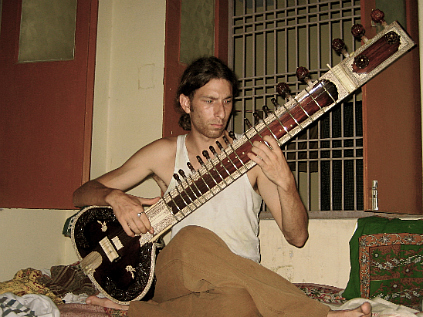A human leg protruded from the funeral pyre. Internal fat and juices were sliding down the foot and bloating the ankle. A white shin appeared as a chunk of meat fell off the bone.
Daily, hundreds of bodies are burned on open pyres along the Ganges River in Varanasi, in India’s province of Uttar Pradesh. The remains are then shoveled into the river. The elderly come here on their deathbed, as Hindus believe they’ll attain instant moksha, or enlightenment, by dying in this holy city.
I watched as one boat floated into the center of the river. A man climbed to the bow, picked up a white object, and dropped it into the murky water. Daily, dozens of children who died before reaching the age of 12 are wrapped in white cloth and dropped into the Ganges, or so I was told. Meanwhile, locals wash their clothes on the riverbanks and bathe in the waters daily, even though they’re known to contain millions of bodies from centuries of cremations. Not to mention high levels of raw sewage.
Claire and I didn’t visit Varanasi out of a weird death fetish. Her hometown friend Joe is here learning from a guru how to play the sitar (a 17-stringed guitar-like instrument, heard in some of the Beatles more experimental songs like “Norwegian Wood”).

Really cool guy. We stayed in his apartment when not touring the city, waking each morning to him practicing his sitar. It sounds a lot more gentle than it looks.
Varanasi is known for its riverside “ghats,” or piers, which run the length of the city and along which the bodies are burned. We arrived October 4 by overnight bus from the Nepali border, and Joe met us on his bicycle at Assi Ghat at the southern end of the city. After we showered and drank several pots of Indian coffee, Joe gave us a tour of the ghats. Death was in our face, and I asked Joe how he felt about being surrounded by burning bodies.
“I was walking along once and saw a dog coming out of the water with a baby’s arm in its mouth,” he said. “Another time, just sticking out of the mud, was this skull, stuff oozing out of it.”
He seemed bothered by it, though it had also become an acceptable part of his routine, just like passing the ghetto on the way to the grocery store, or walking past the homeless guy on the way into the mall. We took a boat across the river to Ramnagar Fort, which is still home to the raj (or king) of Varanasi, though since India gained independence all the maharaja’s have been reduced to figureheads.

More impressive than the fort were the lassis available around the corner for 15 rupees apiece (about $0.30 cents). A creamy homemade yogurt came in a clay pot, topped with yogurt skin and cheese curd. I drank two. Perhaps the most fun part (and guilty) was breaking the clay pot afterward. Apparantly, it was cheaper to buy a new clay pot than to wash the used one, so the vendor didn’t bother washing and reusing them. Which is a waste, but certainly more sanitary than washing the pots in the Ganges river.
I enjoyed that lassi, or any other street food in Varanasi, surrounded by the smell of piss, human shit, and cow dung. Landmines of dung—-about a foot in diameter and six inches deep—-are everywhere. And it’s all shoveled into the holy Ganges River, along with raw sewage and garbage.
Cows roam everywhere, even in the narrowest allies, and Joe says they can sense the foreigners who enjoy eating burgers. Joe said they used to swing their horns at him, but stopped when he became a vegetarian. I’m personally keen on burgers, and when I passed one particular cow, it swung its horns in my direction, but not at Joe. If I stay here too long, I’ll may become both a vegetarian and a regular bather in the fecal-filled river.
